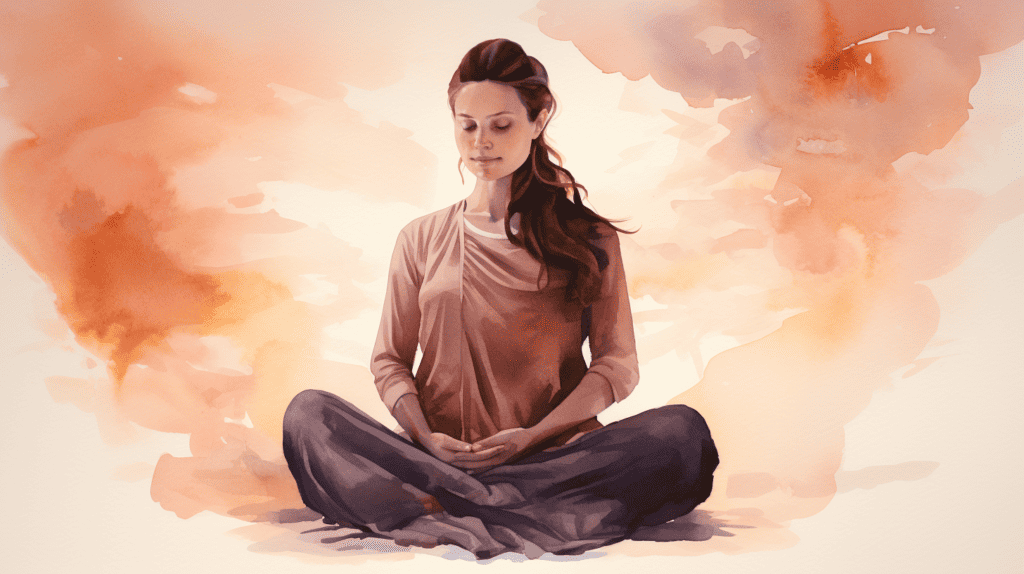Pregnancy can be an exciting but anxiety-provoking time. Hormonal changes, physical discomforts, worries about labor and delivery, and the enormous responsibility of raising a child can all contribute to feelings of anxiety for expectant mothers. While some anxiety is normal, excessive worry during pregnancy has been linked to premature birth and low birth weight babies.
The good news is that meditation for pregnancy anxiety can help reduce stress and promote relaxation during this special time. In this comprehensive guide, we’ll explore how to use meditation, breathing exercises, visualization, and other mindfulness practices to minimize anxiety and maximize calmness throughout your pregnancy journey.
Key Takeaways:
- Mindfulness meditation can effectively reduce anxiety during pregnancy. Start with just 5-10 minutes daily.
- Apps like Calm, Headspace, and Insight Timer have great pregnancy-specific meditations.
- Yoga poses like Child’s Pose and Legs Up the Wall help relax the mind. Move gently.
- Use visualization to replace worrying thoughts. Picture your baby and labor going smoothly.
- Deep breathing into the belly instantly reduces tension. Try 4-7-8 breathing.
- Guided sleep meditations at bedtime improve quality rest.
- Discuss any safety concerns with your OB. But for most, meditation is very beneficial.
What meditation techniques can help reduce anxiety during pregnancy?
Many forms of meditation can help minimize anxiety during pregnancy. Some of the top meditation techniques include:
- Mindfulness meditation involves sitting quietly and focusing your awareness on the present moment, including your breathing, thoughts, and bodily sensations. The goal is to observe calmly without judgment. Mindfulness has been shown to reduce anxiety, stress, and depression during pregnancy and the postpartum period.
- Guided visualizations – Also called guided imagery, this involves listening to a narrator describe relaxing scenes in detail, allowing you to imagine them vividly. Visualizing calm, peaceful settings can promote relaxation and reduce anxious thoughts. Popular visualizations for pregnancy include conceiving your baby in the womb.
- Body scans – Lie down and slowly bring focused awareness to each part of your body from head to toe. Notice any areas of tension or discomfort, breathe into them gently and invite them to relax. This promotes deep relaxation and body awareness.
- Breathing meditations – Sit comfortably and focus solely on taking slow, deep breaths. Counting the breath or repeating a mantra like “peace” can help anchor your attention. Deep breathing stimulates the relaxation response.
- Walking meditation – Mindfully focus on the sensations of walking, your feet connecting with the ground, your breath, and your surroundings. This simple meditation helps redirect anxious thoughts.
- Loving-kindness meditation – Repeat phrases like “May I be healthy,” “May my child be healthy,” “May I feel peaceful,” etc. Wishing yourself and others well can generate goodwill and serenity.
TIP: Experiment with different types of meditation to find which works best for you! Start with just 5-10 minutes daily.
What to Expect advises staying active, as even a 10-minute walk can decrease tension levels, and learning about pregnancy and parenting can help you feel more prepared.
As my due date approached, I was becoming increasingly anxious about labor, delivery, and becoming a new mom. My doula suggested I try a 20-minute guided pregnancy visualization every night before bed to relax and connect with my baby. It helped me detach from anxious thoughts and improved my sleep quality. Now, I fall asleep each night, picturing my little one nestled peacefully in my womb.
How can meditation for pregnancy anxiety help manage stress?
Mindfulness meditation refers to the practice of cultivating nonjudgmental awareness of the present moment. Research shows it can help pregnant women better manage stress and anxiety.
Benefits of mindfulness meditation during pregnancy include:
- Reduces stress reactivity – Mindfulness teaches us to observe our thoughts and emotions as temporary events calmly. This reduces reactivity and stressful feelings.
- Promotes detachment – Viewing worries and fears as passing mental events rather than reality helps us detach from distressing thoughts.
- Improves emotion regulation – Mindfulness improves our ability to cope with anxiety, anger, and sadness through awareness, acceptance, and compassion.
- Enhances self-care – Mindful tuning into your body’s needs improves healthy self-care like nutrition, exercise, sleep, and stress management.
- Deepens mind-body connection – Mindfulness helps pregnant women tune into the sensations and movements of their growing baby.
- May reduce inflammation – Some studies link mindfulness meditation with lower inflammatory conditions correlated with premature birth, low birth weight, and depression.
- Increases relaxation – Mindfulness reduces tension and anxiety by activating the body’s rest & digesting nervous system response.
For high-risk pregnancies or preexisting anxiety, many OBs now recommend Mindfulness-Based Childbirth and Parenting (MBCP) programs to help expectant mothers reduce stress and anxiety. I plan to enroll in one during my second trimester.
Start small – even 5 minutes daily of mindful breathing benefits the body and mind.
I started practicing just 5 minutes of mindfulness meditation when I woke up, focusing on my breath moving in and out. It’s helped me approach my days with much more calm and patience. Those 5 minutes make me a better mom for the rest of the day.
Babylist suggest that pregnancy meditation can be practiced in various ways, from breathing techniques to visualizing the emotional bond with your baby, without any strict guidelines on the best method.
What are the best meditation apps for relaxation and anxiety relief during pregnancy?
Pregnancy meditation apps can provide straightforward, accessible tools for busy moms-to-be to cultivate mindfulness and relaxation. Here are some top-rated apps:
- Expectful – Provides meditations, sleep stories, and yoga for pregnancy and motherhood. It helps reduce anxiety and depression.
- Peaceful Pregnancy – Uses guided imagery and hypnotherapy for relaxing and connecting with your baby.
- Headspace – Offers hundreds of meditations and mindfulness exercises for anxiety, focus, sleep, etc. Very beginner-friendly.
- Calm – Includes beautiful nature scenes, music, and pregnancy-specific meditations for relaxation. Great sleep tools.
- Insight Timer – Free app with thousands of meditations, music, and talks led by over 8,000 teachers. Highly rated by moms.
- Breathe – This is a simple app for guiding mindful breathing sessions. Includes breathing visualizations and reminders.
When searching meditation apps, look for ones that resonate personally and have pregnancy-specific content created by professionals. Read reviews and test out free trials first.
Massage during pregnancy
— Jan (@motherlylovexx) August 20, 2022
Make the pregnancy & labour experience more comfortable giving the mother confidence
Reduce level of pain relief needed & relaxation can help shorten your labour
Benefit your baby’s growth & development
#anxiety #childbirth #maternity #NaturalSkincare pic.twitter.com/4NSFPXSpM7
Around week 25, I started using Calm to relax before bedtime, doing their lovely guided imagery sessions (free for new users). My favorite is imagining floating on a soft cloud over stunning landscapes. It melts my anxieties away, and I sleep much deeper now.
What yoga poses or stretches help relieve anxiety for pregnant women?
Pregnancy yoga is a gentle, effective way to stretch your changing body, gain strength, and relax the mind and muscles. Try these anxiety-relieving yoga poses:
- Child’s Pose – Stretches hips, thighs & spine. Slow, deep breathing in this pose is very calming.
- Cat/Cow Pose – Gently mobilizes spine and belly. Simple motion is meditative.
- Legs Up The Wall – Restorative inversion improves circulation and reduces swelling in feet/legs.
- Supported Forward Bends – Let gravity help stretch and calm your mind. Use bolsters for comfort.
- Wide-Kneed Forward Bend – Hip opener releases tension from hips, lower back, and sacrum. Therapeutic for sciatica.
- Restorative Bridge Pose – Supports back while opening front of hips/thighs. It allows the mind and body to relax.
- Supported Fish/Reclined Hero’s Pose – Opens chest and shoulders. Reduces fatigue during pregnancy. Deeply restorative.
Prenatal yoga classes (online or in-person) are ideal for learning poses safely. I attend a virtual class 2x a week for the community support and the huge anxiety relief a good stretch provides!
TIP: Move slowly, use props to be comfortable, and let go of how the pose “should” look.
Some days, kneeling on my mat for a few deep breaths is enough. Be present with where your body is, not pushing or judging it. That mindset alone reduces my pregnancy anxiety immensely.
How can visualization meditation help pregnant women connect with their babies?

Visualization meditations, where you form mental images to relax or focus your mind, can be profoundly helpful during pregnancy. Visualizing your growing baby promotes bonding and reduces anxiety.
Here are some visualization meditations to try:
- Imagine your baby – Picture their little hands, nose, lips, eyelashes, etc. Visualize them moving and kicking gently. Send them love.
- Imagine your child older – Picture calming scenes like rocking your baby or child laughing and playing. Visualize them as healthy and happy.
- Imagine labor – See your body working efficiently, your partner and doctor supporting you, and the baby descending through the birth canal. Imagine a smooth delivery.
- Imagine breastfeeding – Visualize the soft skin-to-skin contact, rhythmic suckling, oxytocin release, bonding with your infant.
- Imagine positive outcomes – Picture your delivery going perfectly, your recovery peaceful, becoming competent parents, etc. Use visualizations to replace worry.
Guided imagery sessions can provide prompts to evoke relaxing mental scenes. I love doing the “cloud journey” visualization in my Calm app. Envisioning my baby cradled in a soft, floating cloud is so serene and helps us feel more connected.
Make visualization a calming nightly ritual. Dim lights, get cozy, and let your creative mind soar!
Last night, I visualized my daughter at age 5 – her little hands picking wildflowers, blonde braids bobbing as she laughed and explored nature. It filled me with such calm joy and gratitude. Visualization is now my favorite pre-bed relaxation.
What are some beginner meditation tips for pregnant women new to the practice?
Here are some tips for pregnant women just starting a meditation practice:
- Start small – 5-10 mins daily is enough at first. Short, frequent sessions are better than long, occasional ones.
- Find a comfortable seat – Sit cross-legged, kneel, and use a chair or pillows to support you. Allow your belly room to expand.
- Focus on your anchor – Keep returning your focus gently to your anchor, typically the breath, sensations of your body, a word, or an image.
- Accept distracting thoughts – Let them come and go without frustration. Refocus calmly on your anchor.
- Relax your body – Scan for tension. Release clenching and invite shoulders, face, and belly to soften.
- Don’t suppress emotions – Allow yourself to observe and feel without reacting or judging mindfully.
- Be kind to yourself – You’re doing great! There is no perfect way to meditate. Celebrate small successes.
- Try mantras – Repeat phrases in your mind like “I am calm” or “My baby is healthy” to promote relaxation.
- Use apps – Great guided meditations for any time of day to support your practice.
Bupa notes that meditation is an ancient practice with many health benefits and can be particularly beneficial for relaxation and stress relief during pregnancy.
I am new to meditation, too. Starting slowly with 5 minutes of deep breathing when I felt anxious helped me build consistency. Don’t be too hard on yourself starting! Just sit and be present.
TIP: Make meditation an act of self-love. Don’t force it – let it be an oasis of calm you look forward to.
I light a candle now during my short morning meditation, listening to soft music. Treating it as a unique “me time” rather than another chore helped it stick. I can drop my worries, at least for those few minutes.
How long should a pregnant woman meditate each day to reduce anxiety?

There’s no universal magic number for how many minutes pregnant women should meditate to relieve anxiety. But research and experience suggest:
- For beginners, start with just 5-10 minutes per day. This prevents meditation from feeling like a chore.
- As you advance, work up to 10-20 minutes daily for significant anxiety relief.
- Once you’ve built a strong habit, 20-30 minutes daily provides greater resilience to stress.
- For managing diagnosed anxiety or depression, aim for 30-45 minutes of practice daily alongside other prenatal care.
- Break meditation time into smaller sessions if needed – e.g., 10 mins morning, 10 mins mid-day, 10 mins before bed.
The most crucial factor is being consistent. Prioritizing even a short daily meditation practice has been shown to reduce pregnancy anxiety significantly compared to sporadic, longer sessions.
I’m currently doing 15 minutes in the morning, focusing on my breath and any tension in my body. It has worked very well for minimizing my general pregnancy worries and helps me feel prepared for motherhood.
TIP: Think progress over perfection. Any daily meditation will yield benefits, even for just a few minutes!
I no longer beat myself up if I only have time to meditate for 5 minutes some mornings. Sitting and taking deep belly breaths is much better than nothing on busy days.
What breathing exercises or deep breathing techniques can reduce anxiety in pregnancy?
Focused deep breathing is very effective at inducing relaxation and countering anxiety. Here are some beneficial breathing techniques:
- Diaphragmatic breathing – Breathe deep into the belly, allowing it to expand fully. Slowly exhale, pulling your belly in.
- 4-7-8 breathing – Inhale for 4 seconds, hold for 7, exhale for 8. Repeat the cycle several times.
- Equal ratio breathing – Make inhalation, hold, and exhalation equal lengths. E.g., inhale for 5, hold for 5, exhale for 5 seconds.
- Ocean breath – Imagine waves as you inhale and exhale deeply. Picture ocean scenery.
- Counting breaths – Inhale and exhale fully while steadily counting breaths up to 10, then repeat the cycle.
- Obstetric breathing – Rapid shallow breaths during contractions. It helps manage intensity. Learn in birthing class.
The key is breathing rhythmically, centered in the belly. Make it smooth and steady. I do 4-7-8 breathing when anxious, which provides a nearly instant reduction in tension and heart rate.
TIP: Add deep breathing to other meditations by focusing on it as your anchor. It brings quick centeredness.
How can meditation help pregnant women sleep better and reduce anxiety at bedtime?
Many women struggle with insomnia and anxiety at bedtime during pregnancy. Meditation is an excellent natural way to improve sleep quality.
- Mindfulness meditation reduces repetitive worries and brings detachment from daily stressors. This allows the mind to unwind and sleep.
- Body scan meditations relax muscles and enhance the mind-body connection. Releasing physical tension enables rest.
- Visualization meditations focused on calming nature settings lull the mind into drowsiness. Imagine somewhere you feel peaceful.
- Breathing meditations slow the heart rate and lower blood pressure, which primes the body for sleep.
- Guided imagery provides hypnotic relaxation and distraction from a racing mind. Visualize your happy place.
- Gratitude meditation lowers stress hormones and worries by focusing on blessings halting anxious thoughts.
- Progressive muscle relaxation systematically tenses and relaxes muscle groups to melt away tension.
Listening to a 20-minute guided sleep meditation each night made a huge difference in my ability to fall asleep and reduced my pregnancy insomnia. I feel so much more rested in the mornings now.
TIP: Make sleep meditation part of your nightly pre-bed routine for better quality sleep and next-day anxiety relief.
Simply dimming the lights, putting on pajamas, and sitting to meditate signals to my body, that it’s time to relax for sleep. Small routines help at bedtime.
Are there any risks or safety concerns related to meditation during pregnancy that anxious moms should know?
For most women, meditation during pregnancy is very safe and beneficial for maternal mental health. Some tips:
- Avoid lying flat on your back after 1st trimester – it can compress the vena cava vein, reducing circulation. Sit upright or lie on the left side. Use pillows as needed for comfort.
- Modify yoga poses to accommodate belly and relax joints – listen to your body’s limitations. Avoid extremes.
- Stay hydrated and avoid overheating during exercise or prolonged meditation.
- Discontinue any meditation that causes dizziness, rapid heartbeat, or hyperventilation – talk to your OB.
- Avoid intense pranayama breathing exercises without guidance from a prenatal yoga teacher. Normal deep breathing is fine.
- Be aware specific meditation retreats may require extended fasting or other rigorous components – avoid them while pregnant without medical approval.
Most meditation styles can be part of a healthy prenatal self-care routine with reasonable precautions. My OB actively encouraged daily mindfulness meditation during pregnancy to reduce stress and anxiety. Always discuss specific concerns with your provider.
Overall the proven mental health benefits of meditation typically outweigh the potential risks. Pregnant or not, developing a gentle daily meditation practice focused on self-compassion, relaxation, and connecting with your baby is one of the greatest gifts you can give yourself.





Leave a Reply